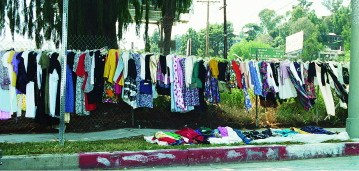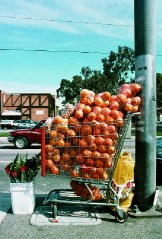On a sunny Saturday afternoon in Los Angeles, a woman buys a funky '50s-era dress. A recent immigrant from El Salvador sells a dozen blue-corn tamales. And a stylish couple pay cash for a vintage Eames chair. It may sound like another day at the mall, but there is not a credit card or cash register in sight. These transactions occur on front lawns, between cars stopped at traffic lights, and in the vast vacant lots of this sprawling city.
 |
| Sidewalk sale: clothing hung out not to dry but to sell |
| Photograph by Margaret Crawford |
By transforming median strips, sidewalks, and front lawns into commercial spaces and attracting clientele of varying classes and ethnicities, street vending and yard sales help redefine the social and economic structures of Los Angeles. Professor of urban design and planning theory Margaret Crawford argues that such informal activities expose community spirit and optimism long written off by urban critics and historians. "These activities identify neighborhoods and communities. They bring disparate groups together," says Crawford, who teaches at the Graduate School of Design. "They reveal the city to people." She examines such issues in "Blurring the Boundaries: Public Space and Private Life," an essay included in Everyday Urbanism, a book on Los Angeles that she coedited. Her analysis draws on years of ethnographic observation as well as interviews she conducted with street vendors throughout the city.
 |
| A shopping cart of oranges offered for sale on a median strip in Los Angeles |
| Photograph by Margaret Crawford |
Crawford's praise stands in stark contrast to the standard architectural criticism of Los Angeles, which disparages the city as a parade of theme-park-style shopping malls and glitzy retail districts. Most critics contend that these commercial interests have devoured public space, and that the city suffers from a resulting dearth of town squares or parks--the traditional areas that encourage community interaction and discourse.
Taking a contrary line, she enthusiastically points out oases of public interaction--in the form of street merchants and yard sales--emerging from unexpected, and heretofore undesirable, areas. She heralds a counter-movement of citizens who are turning public and private spaces into unofficial shops. "Within the totally desolate landscape, there are hives of activity," she says. "They work in the nooks and crannies of the economy."
In a way that transcends traditional images, Crawford has redefined public space to include "everyday space": sidewalks, empty lots, front lawns. But when these bits of common turf are converted into ad-hoc retail venues, Crawford argues, they transform mundane and undesirable space into vibrant places.
In certain neighborhoods, yard sales are daily social events. In Watts, for example, a father-son team sells mattresses of all sizes, piled in lopsided columns, from their paved-over front "lawn." In East Los Angeles, Latina women who hawk clothing from their yards "create a strong female community, in addition to augmenting income," Crawford says. And Latino men set up informal car-repair shops where neighbors inevitably congregate.
Garage sales spill into West Hollywood and other posh districts. In fact, yard sales have become so popular in Beverly Hills that the city now permits households only two per year.
According to Crawford, street-level entrepreneurs humanize the harsh urban environment. Sidewalk vendors, for example, use the chain-link fences surrounding empty lots to display colorful clothes, rugs, and flags. "The chain-link fence becomes a mural of humanity, and the vacant lot becomes a soft landscape," she says. "The transformative possibilities are extremely positive."
Some people complain that unlicensed urban commerce undermines zoning restrictions and property values. "[Traditionally], we call yard sales 'blight,'" Crawford acknowledges. But she adds that as citizens use everyday space (often illegally) to sell wares from their houses, they blur the distinctions separating public, private, and commercial areas. "The most private things are spread out for everyone to see," she says. And even though public displays of domesticity--such as homeless people sleeping in parks--can disturb us, Crawford welcomes street vending and yard sales as catalysts for change. "These activities help us understand space and urban process. They allow us to rethink what is desirable," she says. "And they suggest new possibilities and useful designs."
~Catherine Dupree
Margaret Crawford e-mail address: mcrawford@gsd.harvard.edu





